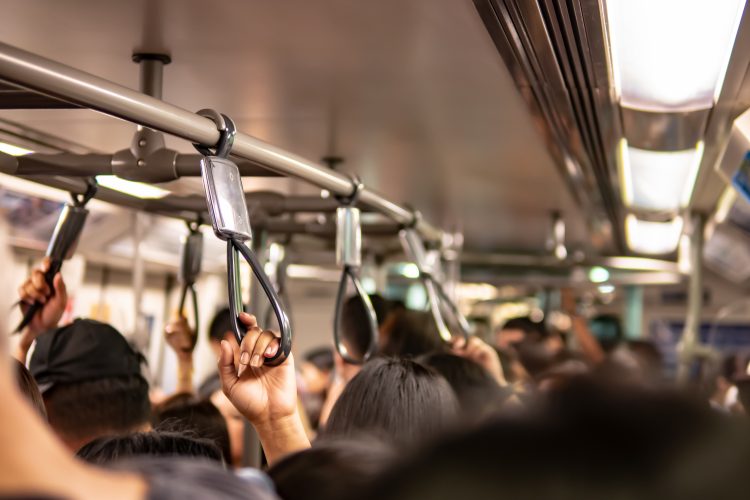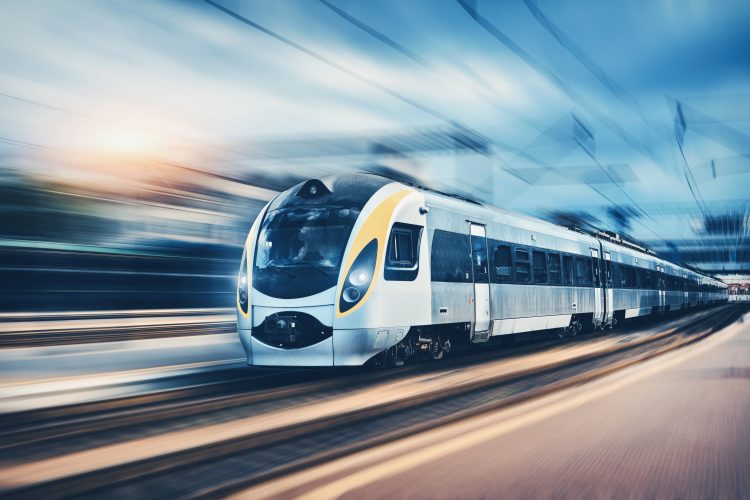Using data to rebuild trust in transport post-pandemic
- Like
- Digg
- Del
- Tumblr
- VKontakte
- Buffer
- Love This
- Odnoklassniki
- Meneame
- Blogger
- Amazon
- Yahoo Mail
- Gmail
- AOL
- Newsvine
- HackerNews
- Evernote
- MySpace
- Mail.ru
- Viadeo
- Line
- Comments
- Yummly
- SMS
- Viber
- Telegram
- Subscribe
- Skype
- Facebook Messenger
- Kakao
- LiveJournal
- Yammer
- Edgar
- Fintel
- Mix
- Instapaper
- Copy Link
Posted: 17 May 2021 | Luke Antoniou - Intelligent Transport, Mike Butler - Nomad Digital, Xavier Champaud - Nomad Digital | No comments yet
Xavier Champaud, Managing Director, and Mike Butler, Head of Strategic Technical Innovation at Nomad Digital, detail how transport operators can win back passengers’ trust following the pandemic and the role that data has to play in any innovation that is going to help along the way.


Considering the current situation for public transportation, what innovations should operators be looking at to aid their recovery from the pandemic? What opportunities do you see for public transport operators at this time?
Xavier Champaud: The pandemic has hit transport operators very hard. Loss of revenue, loss of ridership – despite some support from governments – has created a situation where the industry’s short-term future must be focused on financial recovery.
Today, Nomad Digital views the mobility market as consisting of three main stakeholders: the maintainer, the operator and the passengers. All have a part to play in decreasing costs and increasing revenue.
Mike Butler: In many cases, the rolling stock owners find themselves in a challenging position, too. Before COVID, finding new customers for their off-lease assets was typically easier. Now, they have to look at ways to make their assets more attractive to potential operators. Because ridership will be down for a considerable period, operators don’t currently have that need.
XC: When you look at the decrease of ridership, the numbers that we’ve seen from Australia to North America are as much as an 80 per cent ridership decrease, so you can imagine the loss of revenue, especially in the case of private operation.
MB: The key is to do more with less, but also give confidence to the passenger, the operator, the maintainer, and the rolling stock owner that the data they have is valid, correct and reliable. We need to extract more information from the infrastructure and the vehicles to deliver to all these different stakeholders – and it needs to be done more efficiently and effectively.
XC: Data monetisation is a trend right now, but it only takes full meaning when you start to discuss it with those in charge of rolling stock maintenance, where every piece of information will enable them to anticipate failure or replacement. All these components are cost-saving elements which, in turn, will contribute to decreasing costs.
What’s Nomad’s perspective of the switch in mindset seen in operators over the last year in terms of being more agile with technology adoption?
XC: Firstly, let’s consider the necessity of decreasing maintenance costs. Operators faced with ridership decreases contacted us to see how they could work with us, which led to discussions about our business model. Ultimately, we had to ask how we as a technology provider could move from a business model based on a monthly or yearly subscription to something more dynamic, closely aligned with the new revenue profile of operators.
In the last 12 months, we have been obliged to reconsider the way we provide a service. What are the fixed elements of this service versus the ones that we can make variable? The other aspect to this is the collaboration that can then be generated in your discussion with customers. No technology vendor now is in a purely transactional situation – we are putting proposals forward and hoping to build a longer-term partnership.
MB: There are certain factors we’ve been looking at within this. Nomad provides a data connectivity platform, but that’s actually a tiny part of what we do. We’re enabling a vehicle to be able to extract information from multiple sensors on board. A sensor isn’t necessarily something dedicated to monitoring but could be a CCTV camera. While a CCTV camera is a passive device to record activities on board and off board, implementing Artificial Intelligence (AI) enables operators to begin looking at much more. For example, cameras could look at an asset’s condition, at signal passed at danger – they could even be used for more efficient driver training with virtual route learning
On board, you can use exactly the same CCTV cameras with a processor on board to use AI and identify security threats, overcrowding, passenger capacity, and so on. In the past, CCTV would have been a passive system; now, we use these systems to automatically notify the likes of security services and fleet maintainers of potential issues, either with the rolling stock, the passengers on board, or the infrastructure that vehicles are running on. By IP-enabling these vehicles and providing a robust connectivity platform, we can deliver much better value, and operators can really enhance their connectivity.
Considering COVID-19 and the public transport sector’s recovery, getting that type of information efficiently and making it usable quickly gives the passenger more confidence, not only that services will run on time and won’t break down, but also that they’re going to be able to socially distance. In these times, passengers want reassurance that operators know what’s happening on board in real-time instead of having a train manager or guard passing through every 30 minutes and hoping everything’s okay.
Ultimately, technological innovation over the next few years will be at least somewhat reliant on looking at traditional systems and working out how they can add more value for operators through better connectivity.
The pandemic has made this sector realise that it can’t be passive or reactive any more – it needs to be predictive.


Arming passengers with capacity information is crucial in avoiding scenes such as this one
What can operators do to rebuild passenger trust, reconnect with their customers, and look to not only get back to where they were a year ago in terms of service levels and passenger numbers but take the next step?
MB: Mobility services will be essential, but integral to those are the data flow – and that’s where we can help.
I mentioned using better-connected CCTV to deliver data on elements like passenger loading, but a passenger’s data journey starts a long time before they’re on the service, actually from the moment they leave the house. The more data that operators can provide about how services are performing, the more reassured the passenger would be and the more informed decisions they will make. Improving data flow from the operator to the passenger will be absolutely key here.
Reducing contact points through ticketless travel is not only more efficient but, at this moment in time, obviously vital in reducing the spread of COVID-19. This stretches to apps that not only show ticket information but identify a passenger as being in the right place at the right time for their chosen service. Operators will want to maintain interaction with station staff, but making travel electronic allows the data flow to be a little more dynamic.
XC: It’s not by chance that the Nomad vision has always been holistic – we have believed since the beginning in the notion of connecting everything. Providing smarter transport from the perspective of a passenger travelling from door-to-door, with access to information presented to them by their mobility operator, has always been the vision.
In addition to this is the link that the passenger is establishing with the operator. Today, we can use technology to reinforce the operator’s engagement with the passenger, with passengers commenting on how their journey was and rating any on board services. This input is a lot more elaborative and helps operators to improve the experience that they’re providing.
A good relationship between passenger and operator – plus the perception by the passenger that the operator understands their sentiments – will be vital in rebuilding the trust necessary to drive people back to public transport for their mobility needs.
If information like this becomes more personalised, what advice do you have for operators looking to incorporate that kind of technology as part of their ridership recovery plan?
XC: I would advise them to think outside of the box. If you are a rail operator, you are naturally tapped into the existing system present in railway infrastructure. For example, to predict a train’s arrival time, you rely on signalling. However, train positioning information through GNSS relayed to a passenger app would remove any uncertainty. Passengers on their way to the station or waiting on the platform could see exactly where the train is and when it will arrive.
MB: With internet on board, there are other sensors that can be used for tracking but are still GDPR compliant, eg anonymised MAC addresses. This provides a good indication of where people are and how they’re moving. Depending on the operator’s business model, there are now many third parties taking this information and making a more multimodal approach more seamless. It can only really benefit the industry and its passengers if it comes together to work more closely.
The benefits are there if operators are willing to take the long-term view. The more information that is shared, the greater the confidence for passengers that they’re going to be safe on board, that services will run on time and be reliable.
Making progress here relies on a mindset change across both public and private sector participants in the transport market – information sharing is seen in this negative light, as though doing so is giving up a competitive advantage. Still, the current situation is unsustainable without more collaborative efforts.
Do you think data sharing is the most important aspect of operators being able to futureproof their operations?
MB: It’s a good question – and a difficult one to answer. Data sharing is a starting point, and although the long-term vision of operators and vendors has improved, there’s still a long way to go. For example, there’s still an IP network on the train to this day, with multiple systems that would potentially be connected with the data egress point, but they’re not being used. There are also essentially 50 SIMs sitting on the train doing multiple things with data going to different places.


It’s important the computing potential of modern transport vehicles is utilised
In fairness, the vision has changed in the last five years, and digital transport has played a big part. We’re now trying to combine many systems, share information, go through central egress points for data through data manipulation. The importance and value of data is actually changing mindsets and causing us to look more long term at what we want to do, how much we want to spend maintaining these systems, where the data has to go and what information we want to extract from it.
The more that systems are integrated and have central processes, the better the data distribution and the better the value. The more operators can extract from the vehicle, the platform and the station, the more they can avoid endlessly ripping and replacing, spending vast sums of money on more or less the same slightly newer technology. The realisation is coming to operators that they can do so much more with what they already have, and Nomad is part of that journey for them.
XC: One of the biggest questions facing operators today is how to make their operations futureproof. Public transport operators will play a starring role in climate action, not only in terms of the energy they use to power services but also by using data, predictive maintenance, and journey optimisation. In the same way that we can individualise the data given to the passenger, we can also individualise the data provided to a driver, helping in energy optimisation and journey efficiency.
Some technologies were seen as gadgets five years ago, like crowd detection and vehicle capacity, that have become key in the last year and will continue to be so.
What’s changed most in public transport since you’ve been a part of it?
MB: Trust in data and changed perceptions have helped to make the sector a lot more attractive. I think that shows in our recruitment at Nomad, where we’re recruiting across the world.
When it comes to transport and information services, there is now much greater trust in algorithms. Many people will automatically use Google Maps to get their route from A to B without little or no thought of whether it is the best route. The manipulation and handling of data has completely changed the mindset of travellers.
Uber is an excellent example of how data is making a change in transport; it uses information from passengers, from people’s movements and how they interact with the transport infrastructure, and they’ve become a competitor to mass transit because they know more about passenger journeys than perhaps traditional operators do.
The changing nature of this industry is everywhere you look. Ten years from now, it is not inconceivable that Tesla probably won’t appear as a car manufacturer; they’ll be a battery provider. Uber possibly won’t be a transport operator; they’ll be a data platform provider. The market is really being shaken up, which has to be a good thing.
Looking ahead, what do you have planned at Nomad to keep the public transport sector moving forward?
XC: Innovation, adaptation and flexibility are going to be key aspects over the coming years. Nomad has a unique position in the industry, with knowledge available from a significant volume of fleets that have our technology installed, and where those that need it can see the quality of information, they can extract from the data collected worldwide on different fleets of different manufacturers.
Engagement with operators is absolutely vital. Interestingly, in most operators’ organisations, the IT departments are still separated from those that acquire rolling stock or maintain vehicles or infrastructure. Integration of those different visions is crucial to ensure that everybody has a discussion, sees the overall picture, and appreciates all the added value that data can add to operations.
MB: The pandemic has brought forward many SMEs who were potentially not part of the rail or transport sector who have got some excellent ideas. Nomad is actively involved with several first-of-a-kind applications focused on getting people back on transport. We’re looking at solutions that consider cleanliness on board, air quality, image recognition for security, luggage tracking and a lot more. There are infrastructure monitoring systems that can be applied to train operators without costing millions of pounds.
There are other instances where we’re trying to improve how we connect to vehicles, for example, looking at the use of Satcom in the future. In the past, Satcom was viewed as an expensive alternative to cellular, but there’s a low-orbit system going up at the moment, which could play a part. The key is seamless connectivity, which isn’t available now, and Satcom plays a big part. There are applications for funding streams with the ESA that we’re actively involved with, trying to nurture some small SMEs who’ve got some extremely good ideas, help drive them forward, and help implement their solutions on rail platforms.
XC: The future is pointing Nomad towards this notion of services built on a foundation of data. The value that can be created for the individual, whether that’s a passenger or otherwise, will be analysed very carefully. Ultimately, it will lead to a future for transport that is completely orientated around collecting and organising data and deploying it in a way that is integrated and adjoined for the sake of the services that will rely on it.
Related topics
5G & Transport Communications, Artificial Intelligence, Business Models, COVID-19, Infrastructure & Urban Planning, Intelligent Transport Systems (ITS), Passenger Accessibility, Passenger Experience, Public Transport, Transport Governance & Policy, Travel & Passenger Information
Related modes
Bus & Coach, Light Rail
Related organisations
Nomad Digital
Related people
Mike Butler, Xavier Champaud







